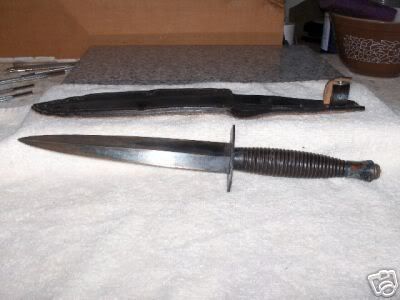I recently bought a Fairbairn Skykes Commando Dagger off of eBay. It seems to be in pretty nice condition, and I think it’s original. The sheat is not (German reproduction). It has “Sheffield England” stamped on the hilt. I cannot wait to get it. It’s a third pattern, I do believe.

Anyway, onto the history.
The Fairbairn-Sykes fighting knife is a stiletto-style dagger developed by William Ewart Fairbairn and Eric Anthony Sykes during World War II with a foil-like handle and a keen, double-edged blade. Modeled on contemporary Shanghai street daggers, it was primarily intended for use by British troops, particularly Commando forces. Manufactured by the Wilkinson Sword Company in England, among others, there were minor variations in pommel and grip, of interest now mainly to collectors. Because of its sleek lines and popular association with the OSS, Marine Raiders and other units, it is often reproduced even today.
British Major Fairbairn, who had been chief of police in Shanghai before the Japanese capture of the city, taught the Fairbairn method of assault and murder. His course was not restricted to Camp X but later given at OSS camps in the United States. All of us who were taught by Major Fairbairn soon realized that he had an honest dislike for anything that smacked of decency in fighting.
Unlike the Marine Ka-Bar, which was designed for use in combat and as a utility tool, the F&S fighting knife was almost brittle, and slender enough to slip between bones. The vase-like handle lent it a very precise grip, and the sharp, double-edged blade was integral to its design. Fairbairn explains the rationale for the knife in his 1942 book Get Tough!
In close-quarters fighting there is no more deadly weapon than the knife. In choosing a knife there are two important factors to bear in mind: balance and keenness. The hilt should fit easily in your hand, and the blade should not be so heavy that it tends to drag the hilt from your fingers in a loose grip. It is essential that the blade have a sharp stabbing point and good cutting edges, because an artery torn through (as against a clean cut) tends to contract and stop the bleeding. If a main artery is cleanly severed, the wounded man will quickly lose consciousness and die.
The Fairbairn-Sykes Fighting Knife, is highly recommended as possessing the requisite qualities. This knife and similar types have found wide favor among experts.
There are many positions in which the knife can be carried. Selection of this position depends upon individual preference based on length of arm, thickness of body, etc. The following considerations, however, should always be borne in mind. A quick draw (an essential in knife fighting) can not be accomplished unless the sheath is firmly secured to the clothing or equipment. More over, speed on the draw can be accomplished only by constant daily practice. The author favors a concealed position, using the left hand, for in close-quarters fighting, the element of surprise is the chief ingredient of success.
